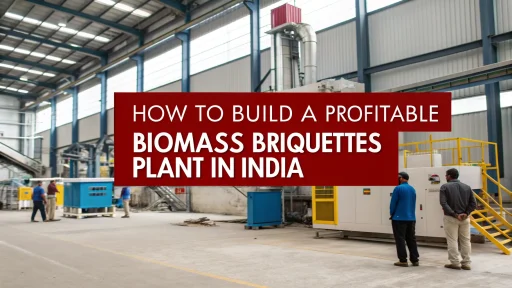In the current climate of increasing fuel costs and pressing environmental problems biomass briquettes have come to prominence as a low-cost, sustainable and environmentally friendly energy option. for Indian entrepreneurs, particularly those seeking to venture into green manufacturing in the future, the biomass briquette business is a fantastic opportunity to maximize profitability while serving a goals.
In this article we’ll show you the steps to build an efficient biomass briquettes production plant completely from beginning to finish in India by understanding the dynamics of demand to knowing the basic materials, the process flow, and potential expansion.
Why Biomass Briquettes? Understanding the Demand and Market Landscape
Biomass briquettes are a sustainable fuel created from organic waste, such as sawdust, agricultural waste wood chips, other biodegradable materials. They are an effective substitute for coal or lignite, firewood and other fossil fuels.
In India the market for biomass briquettes are caused by:
- Industrial Decarbonization: The cement food processing, cement, along with steel manufacturing are moving to biomass-based fuels for boilers and heating units due to environmental regulations as well as the carbon credit incentive.
- Rising cost of fossil fuels The fluctuation of coal prices has led to biomass briquettes becoming an economical and reliable alternative.
- Government-led push for Bioenergy Initiatives under India’s National Bio-Energy Mission, GST benefits (5 percent on Briquettes) and a growing awareness of carbon footprints are pushing industries towards eco-friendly alternatives.
The market for biomass briquettes in India is anticipated to grow steady at a rate of more than 7% over the next few years. Southern as well as western states such as Maharashtra, Gujarat, Tamil Nadu and Karnataka are beginning to emerge as important hubs for consumption and production thanks to agriculture activity and robust industrial bases.
Ideal Raw Materials: What You Need and Where to Source
The flexibility in the biomass briquetting business is its capacity to make use of various kinds of forestry and agricultural waste. They are among the most frequently utilized raw materials:
- Agro Waste: Shells of groundnuts rice husks, cotton stalks sugarcane bagasse grain husks, wheat husks etc.
- The forest waste includes sawdust bamboo dust, wood chips leaves, bark and.
- Other Materials: Paper pulp coconut shells and jute cardboard.
The availability of the raw material differs by region. For example, states that are rich in sugarcane such as Uttar Pradesh and Maharashtra are perfect for briquettes made of bagasse. Similar to that, Punjab and Haryana are abundant in paddy straw as well as wheat husk.
A proper drying and sizing process for the biomass that is used as input is vital. The moisture content should less than 10% to ensure effective Briquetting.
Related: Manufacturing of Biomass Briquettes from Biowaste
Manufacturing Process: From Waste to High-Energy Fuel Blocks
Establishing the biomass briquette facility is an easy process in which forest or agricultural waste is transformed into high-density fuel Briquettes. The way it is carried out:
1. Collection and Drying of Raw Material
The biomass is then collected and dried in order to lower the moisture content. If the moisture level is greater than 10-12%, it can affect the quality and efficiency of combustion of the Briquettes. Drying can be achieved by natural sunlight or using the use of rotary dryers in commercial setups.
2. Crushing or Pulverizing
The dry material is pushed through the crusher or hammermill to break it into smaller, uniform pieces that are suitable for compression.
3. Mixing and Conditioning
In certain instances, binders (like starch or Molasses) could be added to improve the binding ability, but products with high levels of lignin might not require external binders.
4. Briquetting
The material that has been processed is taken into an electric screw or briquetting machine for piston presses and then compressed at high pressure, forming round or rectangle briquettes. The heat produced during compression assists in activating lignin within the material, which in turn helps to bind the particles.
5. Cooling and Packaging
The briquettes that are hot are then chilled before being packaged. Proper packaging (in jute bags, HDPE sacks, etc.) will make it easier to store and transport.
Choosing the Right Location and Infrastructure
The efficiency of biomass briquette plants heavily is dependent on the logistics of raw materials and the location of the customers. When choosing a location:
- Select areas that are rich in forests or agriculture to reduce transport costs.
- Make sure that you have access to electricity throughout the year and water to run machines.
- Choose urban areas or in rural zones where costs for land are lower and labor costs are more affordable.
The standard plant layout comprises areas for storage of raw materials as well as drying yard, crushing section, briquetting room, storage for finished goods and packing.
Applications Across Industries
Biomass Briquettes are replacing coal as well as furnace oil in a variety of industrial applications, such as:
- Boilers are used in Pharma as well as Food Processing Units: Briquettes provide clean energy with a lower amount of emissions and ash.
- Cement as well as Brick Kilns These industries require large amounts of heat, which makes brquettes a perfect solution.
- Steel Rolling Mills and Foundries Biomass may be able to replace coke for heating purposes.
- Hotel and community Kitchens Biomass with low smoke levels is a preferred option in commercial cooking facilities.
The ability to modify the size of briquettes and their composition according to the purpose of use is what makes this product extremely adaptable.
Key Opportunities for Entrepreneurs
A biomass briquettes unit does not just allow entrepreneurs to get into the renewable energy market, but also helps with the management of waste, job creation as well as regional economic growth.
Here are a few examples of areas that startups can be innovative:
- Specialized Briquette Formulatives: We offer briquettes tailored to specific heat requirements of the industry.
- Small Decentralized Units Establishing small-scale plants in farms for use locally and for sale.
- Export-Oriented Production: Due to the increasing demand for exports in Europe in Europe and Southeast Asia, export of biomass briquettes could be an extremely profitable stream.
- Carbon Credit Trade Businesses who make use of biomass waste can sign up as carbon credit holders.
Related: How to Start a Bio Coal Briquettes Manufacturing Business
Support from NPCS
For entrepreneurs who are interested in this area, Niir Project Consultancy Services (NPCS) provides:
- A detailed Market Survey as well as Techno-Economic Feasibility reports specifically designed for biomass briquette plants.
- Reports that describe manufacturing process manufacturing process, raw materials and plant design and financials.
- Expert assistance to evaluate the feasibility of establishing new industrial projects completely from the ground up.
If you’re looking to begin with a small project or develop a commercial green energy system, NPCS helps de-risk your strategy and implementation with tried-and-tested industrial intelligence.
For more information, watch this video
Future Outlook: Green Fuel for a Growing Economy
As India progresses towards their goal of being carbon neutral biomass briquettes, biofuels, will only grow. With increased access to mechanized farming and increasing awareness of the environment that the supply for raw material is not likely to be a hindrance. Indeed, this industry could serve to bridge industrial energy and agricultural demands.
Demand for biomass briquettes is rising as more states adopt cleaner fuel policies. With strong export potential, the future of this market is not only positive but also green and profitable.
Final Thoughts
A profitable biomass Briquette manufacturing plant in India is more than merely leveraging waste. It’s about being part of a global shift towards green energy. With the right equipment, a strong local sourcing strategy, and customer focus, the business can earn steady revenue and support the environment.
Entrepreneurs focused on sustainability and modern manufacturing trends will find the biomass briquette market a strong opportunity. It blends green energy with innovation, supports circular economy goals, and offers scalable demand—benefits that few other industries provide.







